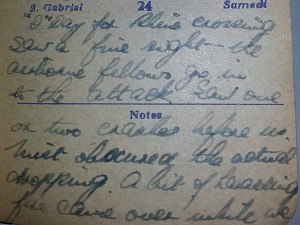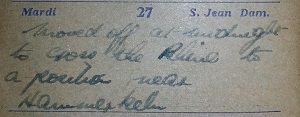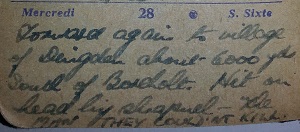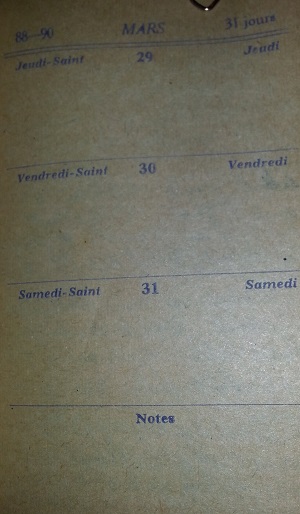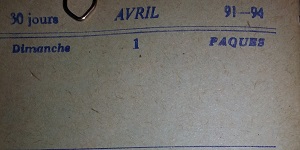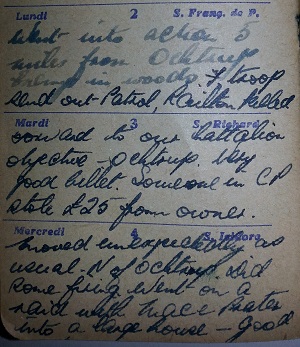The Rhine-crossing - "Operation Plunder"
(24th March to 4th April 1945)
After Operation Market Garden, Operation Plunder was the second attempt to cross the Rhine, in order to advance into Germany.
"Monty had decided that his two Scottish divisions were rather good at assault landings, although neither 15th Scottish nor 51st Highland had participated in the D-Day landings. So they were to be the assault divisions for Operation Plunder - the forcing of the Rhine - and eventually seize the heartland of Das Reich. Lt General Ritchie's XII Corps would then exploit the Rhine bridgehead, and 53rd Welsh would breakout across the river Issel, advance east and capture Bocholt, Stadtlohn, Ahaus, Gronau and Borken. A massive airborne lift backed by a large ferocious barrage should subdue the east bank defences and lead to the capture of Wesel." (Dela96, p.183).
24th-27th March 1945: The Rhine crossing
|
"D"Day for Rhine Crossing. Saw a fine sight - the airborne fellows go in to the attack. Saw one or two crashes before us. ? obscured the actual dropping. A bit of ? fire came over while we waited. ? |
||
|
Fired in support of the airborne It seemed everytime we fired the ?. The comandos took Wesel without ? trouble at all. |
||
| Moved off at midnight to cross the Rhine to a position near Hamminkeln. |
"At 2130 [on 23 March 1945] the artillery barrage started - it was impossible to hear oneself speak, with the roar of guns and sound of shells shrieking overhead." (Hugh16, p. 128)
Patrick Delaforce also describes the perliminary artillery operations for the Rhine-crossing:
"The Divisional gunners had been in action for thirty-six hours, 83rd Field [Regiment] at Ginderich, 133rd Field [Regiment] at Gest sheltered by the huge smoke screens. They fired targets to help 17 US Airborne Division as well as 15th Scottish and 1 Commando Brigade." (Dela96, p.183)
The actual crossing of the Rhine by the 83rd Field Regiment is not described in literature. Nevertheless the date fits, assuming that the artillery crossed the river some time after the infantry.
Barclay describes:
"By the evening of the 25th March a substantial bridgehead over the Rhine had been secured and it was becoming clear that the time for the break-out was approaching. At about 5 p.m. orders were received for the 53rd Division to cross the Rhine at 12 noon on the following day, using the bridges opposite Vynen and Xanten. The 26th was a dull day and congestion on the roads slowed the pace of movement. It was not until about 5 p.m. that the Division began crossing the Rhine [...]. Progress over the bridges, and in the bridgehead, was slow; but by the early hours of the 28th the Division was concentrated North of Wesel, except the 160th Brigade which was further North just West of Hamminkeln." (Barc56, p. 147)
Patrick Delaforce draws a similar picture:
"About 5pm on 26th March, 158 Brigade crossed the Rhine opposite Vynen on a class 12 bridge and the rest of the Division by a class 40 bridge at Xanten. By dawn on the 28th, 71st and 158 Brigades were concentrated north of Wesel and 160 Brigade between Wesel and Bocholt, west of Hamminkeln." (Dela96, p.183)The following map shows the area of the Rhine crossing:
- (Source: Google)
28th March 1945: Dingden, shrapnel hit
| Forward again to village of Dingden about 6000 yds South of Bocholt. Hit on head by shrapnel. The MAN THEY COULD'NT KILL. |
Barclay describes the capture of Dingden as follows:
"The [160th] Brigade then advanced North along the main road to Bocholt, and by midnight 27/28th March the 6th R.W.F., after a sharp action, had captured Dingden, a village about 5 miles due South of Bocholt." (Barc56, p. 147)
"160 Brigade now led, crossed the river Issel just west of Ringenberg, advanced north and 6 RWF captured Dingden at midnight on 27th/28th." (Dela96, p.184)
29th March - 1st April 1945: Bocholt-Winterswijk-Vreden, recovery from shrapnel
| No entries | |
It is a very interesting coincidence, that exactly for the period in which also the liberation of Winterswijk (on 31st March 1945) took place, the author of the diary didn't write any entries, probably because of the shrapnel-hit from 28th March.
During these four days, the 53rd Division liberated Bocholt, Winterswijk and Vreden.
However, since the author of the diary seems to belong to the 83rd Field Regiment Royal Artillery which was attached to the 158th Infantry Brigade, it is very likely, that the author wouldn't be directly involved in the liberation of Winterswijk, since Winterswijk was liberated by the 71st Infantry Brigade.
For a detailed description of the liberation of Winterswijk, see chapter The liberation.
2nd-4th April 1945 - Ochtrup
|
Went into action 5 miles from Ochtrup ? in woods. ? troop send out Patrol, Railton killed. Forward to our battalion objective - Ochtrup. Very good billet, Someone in C.P. stole £25 from owner. Moved unexpectedly as usual N of Ochtrup. ? Went on a raid ? into a large house - good |
Barclay describes the actions around Ochtrup:
"At 8.30 a.m. [on 2nd April 1945] the 7th R.W.F. (in Troop Carying Transport) with A Squadron 3/4 C.L.Y. under command, were directed to cross the Epe bridge and advance along the main East-West road leading to Ochtrup-Rethenberg-Wettringen and Rheine. After minor delays due to enemy action just East of Epe, and to the North-East where the bridge ove rthe Goor stream had been blown, the leading troops were again held up at a strong road block about 2 miles West of Ochtrup. [...] Ochtrup was, however, occupied by 2 a.m. on the 3rd, and final mopping up completed in daylight." (Barc56, p.154)Also the descriptions of Patrick Delaware confirm the actions around Ochtrup:
"Field Marshall Montgomery visited Divisional HQ at Ochtrup on the next day [4th April 1945]. 71st Brigade were clearing around Gronau, 158 Brigade around Ochtrup and 160 Brigade (2 Mons, 6 RWF) clearing the airfield west of Rheine." (Dela96, p.188)Since I assume that the 83rd Field Regiment RA was attached to the 158th Infantry Brigade, the connection to Ochtrup during these days is reasonable. The following map shows the area between Gronau and Rheine:
- (Source: Google)
